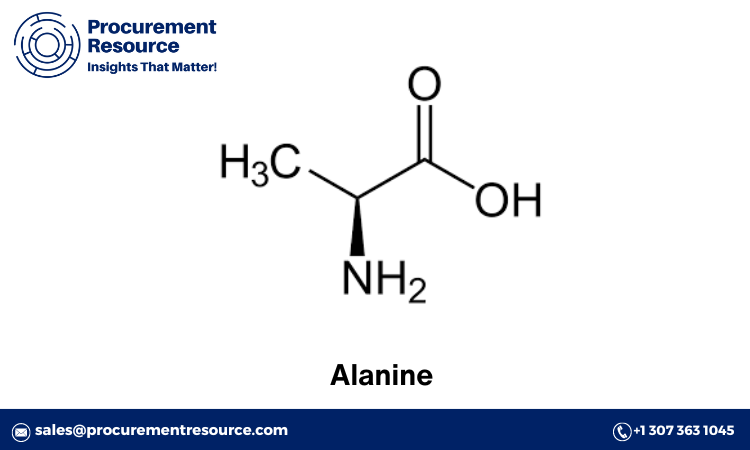
Alanine is a crucial amino acid widely used in various applications, ranging from pharmaceuticals to food supplements. Understanding the production cost of alanine is vital for stakeholders in the industry, including manufacturers, suppliers, and investors. This blog will delve into the cost aspects of alanine production, examining the manufacturing process, raw material costs, and recent developments in the industry.
Manufacturing Report and Process
The production of alanine typically involves chemical synthesis or fermentation processes. Here, we will discuss the two primary methods used:
Chemical Synthesis
In the chemical synthesis of alanine, the process generally starts with the reaction of acetaldehyde with ammonia and hydrogen cyanide, forming 2-aminopropionitrile. This intermediate is then hydrolyzed to produce alanine. The key steps in this process include:
- Preparation of Acetaldehyde: Acetaldehyde is synthesized from ethylene or ethanol through oxidation.
- Reaction with Ammonia and Hydrogen Cyanide: The acetaldehyde reacts with ammonia and hydrogen cyanide to form 2-aminopropionitrile.
- Hydrolysis: The 2-aminopropionitrile undergoes hydrolysis to yield alanine.
- Purification: The crude alanine is purified through crystallization or other suitable methods to achieve the desired purity.
Request For Sample: https://www.procurementresource.com/production-cost-report-store/alanine/request-sample
Fermentation
Fermentation is an alternative method that involves the use of microorganisms to produce alanine. This process is considered more environmentally friendly and sustainable compared to chemical synthesis. The steps include:
- Microbial Selection: Specific strains of microorganisms, such as Escherichia coli, are selected for their ability to produce alanine.
- Fermentation: The microorganisms are cultured in a nutrient-rich medium containing a carbon source (such as glucose), nitrogen source, and other necessary nutrients.
- Extraction: After fermentation, the culture broth is subjected to downstream processing to extract alanine.
- Purification: Similar to the chemical synthesis method, the extracted alanine is purified to obtain the final product.
Both methods have their advantages and limitations. Chemical synthesis is typically faster and can be scaled up easily, but it may involve the use of hazardous chemicals. On the other hand, fermentation is more sustainable but may require more time and control over the fermentation conditions.
Raw Material Costs
The cost of raw materials is a significant factor in the overall production cost of alanine. Here, we will break down the primary raw materials used in both chemical synthesis and fermentation processes.
Chemical Synthesis Raw Materials
- Acetaldehyde: This is a key raw material, and its price can fluctuate based on the supply and demand dynamics in the ethylene or ethanol markets.
- Ammonia: The cost of ammonia is influenced by the natural gas market, as it is a primary feedstock for ammonia production.
- Hydrogen Cyanide: This highly toxic chemical is used in the synthesis process, and its cost is dependent on the production scale and safety measures required for handling.
- Catalysts and Reagents: Various catalysts and reagents are used in the synthesis process, contributing to the overall raw material costs.
Fermentation Raw Materials
- Glucose: This is the primary carbon source for the microorganisms and can be derived from corn or other carbohydrate sources. Its price is influenced by the agricultural market.
- Nitrogen Source: Common nitrogen sources include ammonium sulfate or other nitrogenous compounds, which add to the raw material costs.
- Nutrients and Growth Media: Additional nutrients and growth media components are required to support microbial growth and production.
Cost Analysis
The cost of raw materials can vary significantly based on geographic location, market conditions, and supplier agreements. For instance, the price of glucose may be lower in regions with abundant agricultural produce, while the cost of hydrogen cyanide can be higher due to stringent safety regulations.
To accurately estimate the raw material costs for alanine production, it is essential to consider these factors and conduct a detailed cost analysis specific to the chosen production method and location.
Latest News
The alanine production industry is dynamic, with continuous advancements in technology and changes in market conditions. Keeping abreast of the latest news and developments is crucial for stakeholders. Here are some of the recent trends and news in the alanine production industry:
Technological Advancements
Recent advancements in biotechnology have led to the development of more efficient microbial strains for alanine production. These genetically engineered strains can produce higher yields of alanine, reducing the overall production cost and making the fermentation process more competitive with chemical synthesis.
Market Trends
The demand for alanine is increasing due to its widespread applications in the pharmaceutical, food, and sports nutrition industries. This growing demand is driving research and development efforts to improve production efficiency and reduce costs.
Environmental Regulations
Stringent environmental regulations are pushing manufacturers to adopt greener production methods. The fermentation process, being more environmentally friendly, is gaining traction as a preferred method for alanine production.
Strategic Partnerships
Several companies are forming strategic partnerships to enhance their production capabilities and market reach. These collaborations aim to leverage each other’s strengths in technology, raw material sourcing, and distribution networks.
Price Fluctuations
The prices of key raw materials, such as glucose and acetaldehyde, have shown fluctuations due to various factors, including changes in agricultural output and petrochemical market dynamics. Monitoring these price trends is essential for optimizing production costs.
Conclusion
Understanding the production cost of alanine involves a detailed analysis of the manufacturing processes, raw material costs, and the latest industry developments. By keeping up with technological advancements, market trends, and regulatory changes, stakeholders can make informed decisions to optimize their production processes and stay competitive in the market. Whether through chemical synthesis or fermentation, efficient and cost-effective production of alanine is crucial for meeting the growing demand in various industries.






